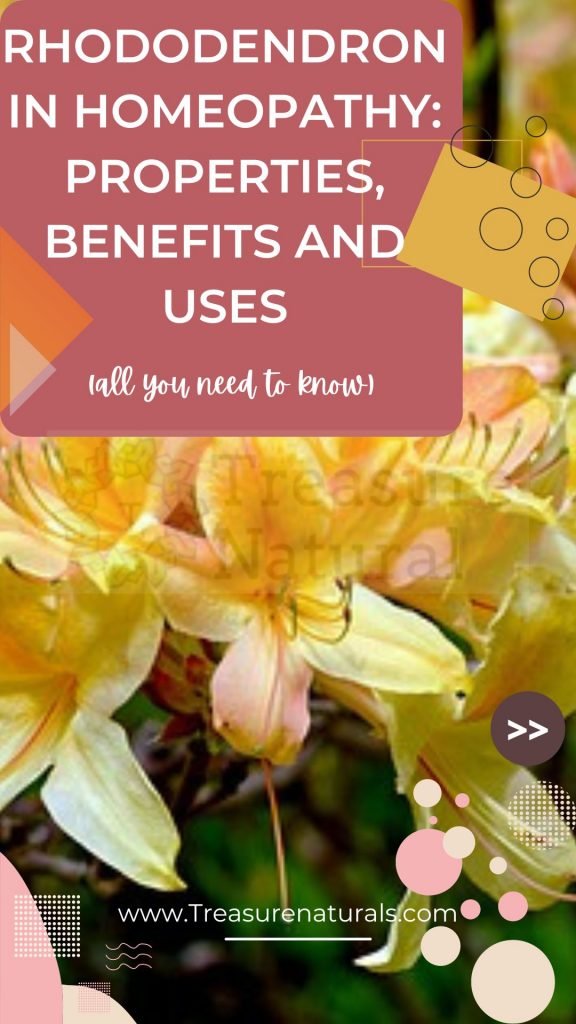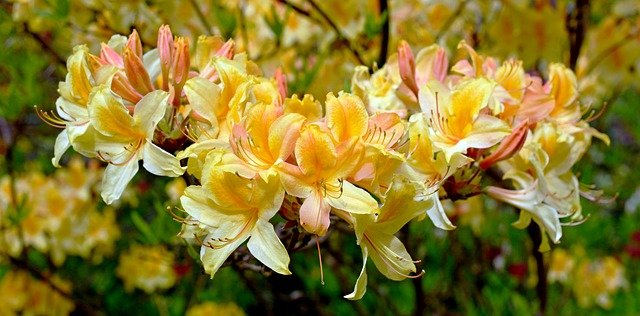
The homeopathic remedy Rhododendron is obtained from the plant Rhododendron chrysantum or yellow rhododendron, a shrub belonging to the Ericaceae family. This is the remedy of choice for all those whose rheumatic or neuralgic pains are accentuated as the storm approaches, when the atmosphere is charged with electricity.
Rhododendron: features of the plant
Rhododendron chrysantum is a plant belonging to the genus Rhododendron, or small shrubs of the Ericaceae family. In general, all plants belonging to the genus Rhododendron are grown mostly for ornamental purposes. In the extensive varietal landscape – comprising over 500 rhododendron trees or shrubs – some species are known and used for their multiple medicinal virtues.
Rhododendron chrysanthum is typical of Asian regions and is used in phytotherapeutics for its hypotensive, antirheumatic, antitussive and expectorant properties. This variety is also used in Homeopathy: the mother tincture obtained from leaves and branches is useful in case of neuralgia and rheumatic pain.
These properties are attributed to rhododendron due to the presence of certain chemical constituents, such as:
- andromedotoxin (tetracyclic diterpene);
- campeol;
- quercetin;
- hyperoside (flavonoids);
- arbutin;
- essential oil;
- citric acid.
In the past this plant was brought to Europe from Siberia where it was traditionally used as an herbal treatment for rheumatism and gout.
The various species are all united by magnificent and showy blooms, but despite their appearance these plants produce toxic effects, even if these occur only after the intake of significant amounts of extract.
Rhododendron: Homeopathic remedy
The homeopathic remedy Rhododendron was tested in 1831. The mother tincture is obtained from twigs whose chemical constituents have antirheumatic (andromedotoxin, a diterpene), expectorant (chemferol), antitussigenic (quercetin, hyperoside) and neurological properties with hypotension, bradycardia, respiratory depression.
Rhododendron is mainly used for the action on rheumatic pains of various kinds and shares with Phosphorus, a soil medicine that is often associated, the aggravation with the approach of thunderstorms.
It is mainly used in the following cases:
- articular rheumatism especially in the small joints (such as forearm and fingers) with meteosensitivity; worsening before a thunderstorm or storm;
- arthritis
- gout;
- fever;
- delirium;
- headaches;
- neuralgic pains in the eyes;
- testicular inflammations.
Rhododendron : The homeopathic remedy for rheumatism
The term rheumatism indicates various disorders related to internal organs, muscles, bones and joints. In general, however, rheumatism means the painful impairment of the musculoskeletal system and therefore the disease that affects the joints.
There are different types of rheumatism:
- inflammatory rheumatism (arthritis);
- degenerative rheumatism (arthrosis);
- extra-articular rheumatism (rheumatic diseases of the tendons, ligaments and connective tissue structures);
- connective tissue diseases (autoimmune rheumatic diseases with chronic inflammation of connective tissue).
To treat rheumatism, several homeopathic remedies are valid that will be prescribed by the doctor on the basis of the subjective symptomatology reported by the patient and in particular on the methods of manifestation of painful symptoms. The homeopathic remedy Rhododendron tends to be prescribed when the subject is suffering from fixed or erratic rheumatic pains that worsen with rest, but that improve from the first movements. When they are erratic, as often happens, they move in a zigzag pattern and most frequently affect the upper and right parts of the body. As already mentioned, a characteristic of patients who benefit from this remedy is that the symptoms worsen as a thunderstorm approaches.
Rhododendron : constitutional type in homeopathy

The constitutional subject Rhododendron is nervous and afraid of thunderstorms. In general, it has the following clinical features:
Mental symptoms
Mental symptoms of this constitutional type include:
- delirium with horrible content;
- fear;
- affective indifference;
- confusion;
- labile memory;
- dullness;
- daytime drowsiness.
Local symptoms
Local symptoms include:
- Head: rheumatic headaches with pain in the bones of the skull; at the top and temples; worsens in the morning in bed and improves after getting up; worsens with wine, wet weather and cold, improves with hot applications.
- Eyes: asthenopia, glaucoma, ciliary neuralgia, pains worsen with the onset of bad weather.
- Face: facial neuralgia, the pains are sharp, tie-rod and improve by eating and with local hot applications.
- Teeth: neuralgic toothache caused by cold and improved by heat and eating.
- Chest: Chronic pain under the 12 left rib that improves by eating.
- Extremities: rheumatic pains in the limbs and joints felt deeply as if they were in the bones or periosteum. These pains often disappear indefinitely in a capricious manner, but they always respect the general rule of reappearing or increasing during a thunderstorm. Pains are always associated with coldness of the extremities. They get worse by standing still, in the morning in bed and improve with movement, which gives instant relief.
- Male genital apparatus: orchitis and epididymitis with hardened swollen testicles with extensive pain in the abdomen and feeling of crushed testicle.
The symptoms of this subject worsen at night, before thunderstorms, with rest, starting to move and standing a lot. Instead, they improve with heat, eating and after thunderstorms.






